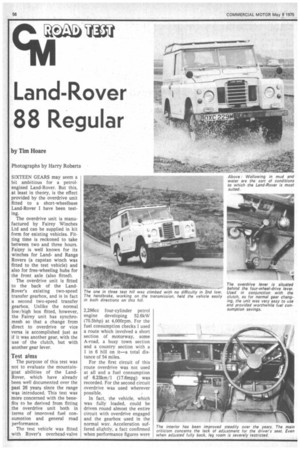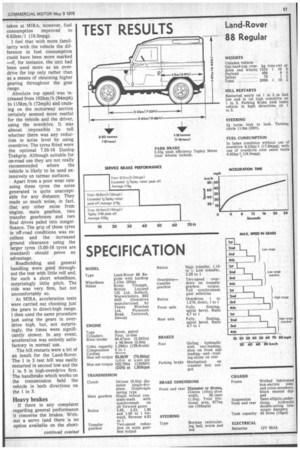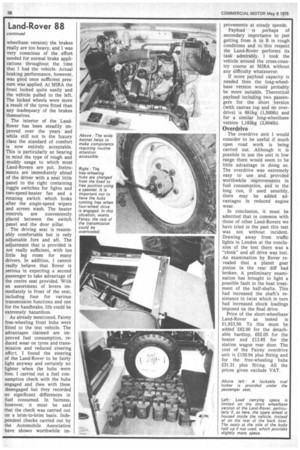Land-Rover 88 Regular
Page 46

Page 47

Page 48

If you've noticed an error in this article please click here to report it so we can fix it.
by Tim Hoare
Photographs by Harry Roberts SIXTEEN GEARS may seem a bit ambitious for a petrolengined Land-Rover. But this, at least in theory, is the effect provided by the overdrive unit fitted to a short-wheelbase Land-Rover I have been testing.
The overdrive unit is manufactured by Fairey Winches Ltd and can be supplied in kit form for existing vehicles. Fitting time is reckoned to take between two and three hours. Faicey is well known for its winches for Landand Range Rovers (a capstan winch was fitted to the test vehicle) and also for free-wheeling hubs for the front axle (also fitted).
The overdrive unit is fitted to the back of the LandRover's existing two-speed transfer gearbox, and is in fact a second two-speed transfer gearbox. Unlike the normal low/high box fitted, however, the Fairey unit has synchromesh so that a change from direct to overdrive or vice versa is accomplished just as if it was another gear, with the use of the clutch, but with another gear lever.
Test aims
The purpose of this test was not to evaluate the mountaingoat abilities of the LandRover, which have already been well documented over the past 26 years since the range was introduced. This test was more concerned with the benefits to be derived from fitting the overdrive unit both in terms of improved fuel consumption and general road performance.
The test vehicle was fitted with Rover's overhead-valve 2,286cc four-cylinder petrol engine developing 52.6kW (70,5bhp) at 4,000rpm. For the fuel consumption checks I used a route which involved a short section of motorway, some A-road, a busy town section and a country section with a 1 in 6 hill on it—a total distance of 54 miles.
For the first circuit of this route overdrive was not used at all and a fuel consumption of 6.23km/1 (17.6mpg) was recorded. For the second circuit overdrive was used wherever possible.
In fact, the vehicle, which was fully loaded, could be driven round almost the entire circuit with overdrive engaged and the gearbox used in the normal way. Acceleration suffered slightly, a fact confirmed when performance figures were taken at MIRA; however, fuel consumption improved to 6.82km/1 (19.3mpg).
I feel that with more familiarity with the vehicle the difference in fuel consumption could have been more marked -if, for instance, the unit had been used more as an overdrive for top only rather than as a means of obtaining higher gearing throughout the gear range.
Absolute top speed was increased from 102km/h (64mph) to 115km/h (72mph) and cruising on the motorway section certainly seemed more restful for the vehicle and the driver, using the overdrive. It was almost impossible to tell whether there was any reduction in noise level by using overdrive. The tyres fitted were the optional 7.50-16 Dunlop Trakgrip. Although suitable for on-road use they are not really recommended where the vehicle is likely to be used extensively on tarmac surfaces.
Apart from a poor wear rate using these tyres the noise generated is quite unacceptable for any distance. They made so much noise, in fact, that any other noise from engine, main gearbox, two transfer gearboxes and two final drives paled into insignificance. The grip of these tyres in off-road conditions was excellent and the increased ground clearance using the larger tyres (5.00-16 tyres are standard) should prove an advantage.
Roadholding and general handling were good throughout the test with little roll and, for such a short wheelbase, surprisingly little pitch. The ride was very firm, but not uncomfortably so.
At MIRA, acceleration tests were carried out choosing just the gears in direct-high range. I then used the same procedure just using the gears in overdrive high, but, not surprisingly, the times were significantly slower. In any event, acceleration was entirely satisfactory in normal use.
The hill restarts were a bit of an insult for the Land-Rover. The 1 in 3 test hill was easily restarted in second low and the 1 in 5 in high-overdrive first. The handbrake which works on the transmission held the vehicle in both directions on the I in 3.
Heavy brakes
If there is any complaint regarding general performance it concerns the brakes. Without a servo (and there is no option available on the short wheelbase version) the brakes really are too heavy, and I was very conscious of the effort needed for normal brake applications throughout the time that I had the vehicle. Actual braking performance, however, was good once sufficient pressure was applied. At MIRA the front locked quite easily and the vehicle pulled to the left. The locked wheels were more a result of the tyres fitted than any inadequacy of the brakes themselves.
The interior of the LandRover has been steadily improved over the years and while still not in the luxury class the standard of comfort is now entirely acceptable. This is particularly so bearing in mind the type of rough and muddy usage to which most Land-Rovers are put. Instruments are immediately ahead of the driver with a neat little panel to the right containing toggle switches for lights and two-speed-heater fan and a rotating switch which looks after the single-speed wipers and screen wash. The heater controls are conveniently placed between the switch panel and the door pillar.
The driving seat is reasonably comfortable but is only adjustable fore and aft. The adjustment that is provided is not really sufficient, with too little leg room for many drivers. In addition, I cannot really believe that Rover is serious in expecting a second passenger to take advantage of the centre seat provided. With an assortment of levers immediately in front of the seat, including four for various transmission functions and one for the handbrake, life could be extremely hazardous.
As already mentioned, Fairey free-wheeling front hubs were fitted to the test vehicle. The advantages claimed are improved fuel consumption, reduced wear on tyres and transmission and reduced steering effort. I found the steering of the Land-Rover to be fairly light anyway and certainly no lighter when the hubs were free. I carried out a fuel consumption check with the hubs engaged and then with them disengaged but they recorded no significant differences in fuel consumed. In fairness, however, it must be said that the check was carried out on a brim-to-brim basis. Independent checks carried out by the Automobile Association have shown worthwhile im provements at steady speeds.
Payload is perhaps of secondary importance to just getting from A to B in rough conditions and in this respect the Land-Rover performs its task admirably. I took the vehicle around the cross-country course at MIRA without any difficulty whatsoever.
If more payload capacity is needed then the long-wheelbase version would probably be more suitable. Theoretical payload including two passengers for the short version (with canvas top and no overdrive) is 681kg (1,5001b) and for a similar long-wheelbase version I,183kg (2,6041b).
Overdrive
The overdrive unit I would consider to be useful if much open road work is being carried out. Although it is possible to use the unit in low range there would seem to he little advantage in doing so. The overdrive was extremely easy to use and provided worthwhile improvements in fuel consumption, and in the long run, if used sensibly, there may be added advantages in reduced engine wear.
In conclusion, it must be admitted that in common with those of other Land-Rovers we have tried in the past this test was not without incident. Drawing away from traffic lights in London at the conclusion of the test there was a "clonk" and all drive was lost. An examination by Rover revealed that a planet gear pinion in the rear diff had broken. A preliminary examination has brought to light a possible fault in the heat treatment of the half-shafts. This had increased the shaft's resistance to twist which in turn had increased shock loadings imposed on the final drive.
Price of the short-wheelbase Land-Rover as tested is £1,923.50. To this must he added £82.90 for the detachable hardtop, £62.05 for the heater and £12.65 for the station wagon rear door. The cost of the Fairey overdrive unit is £150.94 plus fitting and for the free-wheeling hubs £31.21 plus fitting. All the prices given exclude VAT.




























































































































































